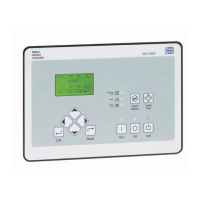4-38 DGC-2020 BESTCOMSPlus Software 9400200990 Rev I
Figure 4-35. Generator Capability Curve vs. 40Q Response
If reactive power is within the 40Q tripping region for the duration of the 40Q activation delay setting
B
, a
loss of excitation condition is annunciated. A loss of excitation annunciation can be user-selected to
trigger a pre-alarm
C
(warning) or alarm
C
(shutdown). A loss of excitation annunciation can also be user-
configured to close a programmable output. The calculation used in the DGC-2020 for the approximate
tripping region is given by:
Tripping Region = 40Q Pickup + (1/8) ∗ ((Actual Watts ∗ 100)/Rated var)
where the units of the Tripping Region and the 40Q Pickup setting are percent of rated var.
The hysteresis setting
D
functions as a loss of excitation dropout by preventing rapid switching of the
pickup output.
Activation delays
B
are recommended for tripping. Adding a small delay will help assure that false alarms
do not occur for transient fault conditions or swings in the power system.
BESTCOMSPlus loss of excitation protection settings (DGC-2020, Generator Protection, Loss of
Excitation) are illustrated in
Figure 4-36.
Figure 4-36. Loss of Excitation Protection Settings
A
Pickup: Adjustable from -150% to 0% of rated vars in 0.1% increments.
B
Activation Delay: Adjustable from 0 to 30 s in 0.1 s increments.
C
Alarm Configuration: None, Alarm, or Prealarm.
D
Hysteresis: Adjustable from 1% to 10% in 0.1% increments.
Overcurrent Protection (51-1, 51-2)
Two sets of overcurrent settings are provided for each element: one for three-phase generator
connections and one for single-phase generator connections. The pickup setting entered is based on the
www . ElectricalPartManuals . com

